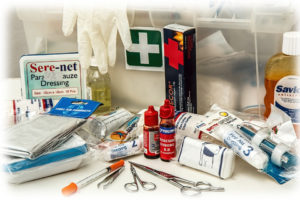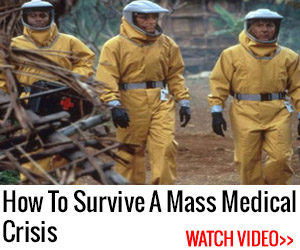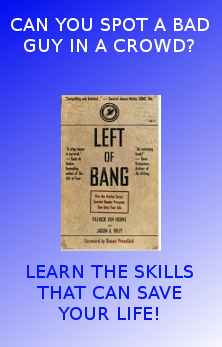
Feb 15
What Makes The Best Survival First Aid Kit?

Whether you’re hunting, hiking, playing sports, or running from Neegan while hiding from a zombie horde, it’s essential to have a good first aid kit.
We’ll show you just how easy it is to build your own first aid kit from scratch, as well as show you some good retail kits that can really save your bacon. One thing everybody overlooks in a first aid kit (or just about anything prepping for that matter) is simplicity.
While we want to be prepared for anything, small or large, we need to remember the 80/20 rule: Don’t spend 80% of your resources on things that will affect you 20% of the time. The principles in our article on Prepping Wrong apply to your first aid kit as well.
Our kit will contain items necessary to treat major wounds, but let’s start with the basics. When you’re out and about, minor scrapes and abrasions, headache, and diarrhea are some of the most likely things you’ll suffer from.
Hardware for the Kit
-
Tweezers
-
Q-Tips
-
Scissors
-
Nail Clippers
-
Thermometer
-
Scalpel
-
Luci Light (Space saving and will burn all night)
Meds for the Kit
-
Ibuprofen
-
Immodium (or store brand)
-
Aspirin
-
Sudafed (or store brand)
-
Acetaminophen
-
Benadryl (or store brand antihistamine)
-
Laxative
-
Iodine
-
Neosporin
-
Hand sanitizer
-
Hydrocortisone
-
Smelling salts
Treating Wounds
As we stated, most wounds will likely be small cuts and blisters. Mild scrapes and the like. Serious wounds and trauma are more rare, but can be very scary. Please remember that nothing can replace a hospital or doctor visit for serious wounds! Most of us are woefully unprepared to treat trauma, and when the time comes keeping calm is the best first step that anyone should take.
For those times when a hospital is out of range, or for the time before we can get to a hospital the following items will help treat wounds of any caliber.
Trauma Items
-
Nitrile (rubber) gloves
-
Syringe (for wound irrigation)
-
Medical tape
-
Alcohol wipes
-
Various size Band-Aids
-
Gauze pads
-
Ace Bandages
-
Tourniquet
-
Suture kit
-
Butterfly closure
-
Tegaderm
-
Blood clot powder
Personal Kit Items
Many times there will be personal things you or your family will need. Does anyone have an inhaler? Some of these items are prescription, so use them at your own risk. Part of being prepared is being smart, and knowing what you can and cannot handle. Please be responsible!
-
Inhaler
-
Epi Pen
-
Sunscreen
-
Lighter/matches
-
Toothbrush/paste
-
550 Paracord
-
Signal mirror
-
Tampons (good for nose bleeds as well!)
-
Water bottles
Putting it all Together
Once you have all of the items you require for your kit, you’re going to want a bag or container to keep it organized. Most retail kits are housed in canvas bags or backpacks. Your container should be easy to carry and store, yet still be protective enough for the items inside.
There are numerous dollar store containers available which can be used to separate the items by type. We recommend separation as follows:
-
Trauma Items
-
Prescription Items
-
Other meds
-
Items needed for minor occurrences
Since you won’t have much time when trauma items are needed, be sure they’re accessible and easy to reach. We have a large first aid kit in a rubbermaid container in the camper, and smaller ones in each car. Package yours to match your lifestyle.
What about buying kits?
No abundance of spare time? Buying survival first aid kits is definitely a viable and fast way to get up and running quickly. We still buy smaller kits for personal carry, and our first big family kit was a portable surgical hospital from Cheaper Than Dirt. Here are a few of our favorites:
LIghtning X Molle Trauma Kit: This kit is designed more for trauma, but the molle fasteners and small form factor make it very useful. Can be augmented with personal items as well.
This 85 pc kit from Walmart was carried in all of our cars for years. It lacks major trauma items, but for most kid scrapes and such it’ll do the trick. And the price is right at under $5!
No matter which way you go, having the biggest, best kit available will do you NO GOOD without some know-how!
Invest in some training for yourselves and your family. There are plenty of free resources to get you started.
First Aid for Free – Site with free training and printable certificates upon completion.
First Aid Web – Another free training site with certification
Boy Scouts of America – Getting involved with Scouting is a good way for kids to learn first aid.
And there are numerous books available on the subject.
So get your kit on, get some knowledge and be prepared for whatever the world throws at you!
Stay safe! Freedom is Within You!
Jan 30
Interrogation Techniques – From Gray Man
From a lecture regarding the persuasion techniques used in interrogation. This information can be used everywhere from casual conversation to negotiating in the workplace.
Jan 22
When People Start Getting Shot, It Gets Real Very Fast
This is no video game
When the driver for this news crew gets a headshot by a sniper, it gets very real very fast.
This is from our friends at Funker530 Combat Footage
Jan 21
Why Is America’s Education System A Failure
How has public education failed you today?
Adapted from a speech by Senator Ann O’Connell, emphasis is mine. Don’t take this as an indictment of teachers. They are merely products of this same system, and often times don’t even have a say in the curriculum they teach. This is about the system as a whole.
How do we Americans begin to understand the problems we are experiencing today with our educational community and with our system of education? Oddly enough, the answer to this go back in history to Napoleon’s defeat of the Prussian army in 1806. Because of the Prussian failure to defeat Napoleon, Germany took a long hard look at its institutions—primarily its school system. This introspection led to the conclusion that Prussian pride and power could only be restored by restructuring that system.
A strategy was devised in which the Prussian government would set up a forced government educational system which would turn out well disciplined students who would follow orders without questioning authority. To accomplish this feat, the goal of educating children became a national priority permeated with strategies adapted to turn out a national work force rather then an educated citizenry. Every step in the education process was calculated to offer authority figures the least amount of trouble and consequently train a well disciplined albeit docile citizen.
“Education should aim at destroying free will so that after pupils are thus schooled they will be incapable throughout the rest of their lives of thinking or acting otherwise than as their school masters would have wished … When the technique has been perfected, every government that has been in charge of education for more than one generation will be able to control its subjects securely without the need of armies or policemen.” – Johann Frichte Prussian University Berlin
Of course the government’s attitude towards ordinary citizens did not carry over to the aristocratic upper classes, about 200 families, that owned most of the property and controlled the purse strings in Prussia—and who were intent on keeping it that way. These families did not want their children attending school with the lower classes and in the course of things the new educational protocol gave the upper classes choice in deciding the kind of schools their children would attend, a choice it did not offer to the average German.
The Prussian system may seem familiar to Americans in that it demanded compulsory attendance, national training for teachers, national testing for all students (important because it gave the government the ability to classify children for potential job training), national curriculum set for each grade, and mandatory kindergarten. Mandatory kindergarten was necessary because it served to break the influence of the mother over the child thus making the child more responsive to government influence.
So how did the Prussian system get from Germany to the United States and what reasons were offered for its adoption here? The Prussian system proved to be a success for that government’s purposes. By the late 1800’s men in the United States including Horace Mann, Barnis Sears, and Calvin Stove heard about the successes of the Prussian system. They traveled to Germany to investigate how the educational process worked. Upon their return to the United States they lobbied heavily to have the Prussian model adopted.
How it Used to Be
Up until the late 1800’s a good education in the United States could be obtained without government interference or oversight. Surprisingly, 50 percent of a population of 3 million in 1776 were indentured servants and 20 percent were African slaves. Yet during that time 600,000 copies of Thomas Paine’s Common Sense had been sold in the United States and had been read by countless Americans. By 1812, with a population of approximately 7 million, Pierre DuPont wrote in Education in the United States, “…that out of every 1,000 persons fewer than four can’t read or do numbers.” He attributed this fact to traditional dinner table debates over passages read from the Bible. In other words, children learned how to read with an understanding of what they were reading and they knew their numbers. All this education took place at home or in one room school houses, or “Dame Schools,” primarily taught by women. The children who came out of these schools grew up to be self reliant and individualistic, in marked contrast to the Prussian system which produced an obedient, collectivist trained populace.
Another development added to the growing furor and revolution in American education. In the early 1800’s, what is commonly known as the Ph.D. did not exist in the United States. Then a well connected American named Edward Everett went to Germany to take courses and returned to this country as the first American to receive a Ph.D. degree. Eventually, 10,000 of America’s wealthiest families would send their sons to obtain the Ph.D. in Prussian universities. Ultimately, this development would affect the educational and intellectual make up of the entire education system from kindergarten through college. These German trained Ph.D.’s took over the educational establishment in the United States and anchored themselves in positions of political and economic power and influence. The substance of the course work in Prussian universities in tandem with the educational philosophy tended to be socialist and collectivist in nature. Consequently, the knowledge and mind set of the Prussian system were passed on to several generations of American intellectuals.
Implementation of the Prussian System
Implementation of the Prussian system was to become the goal of Edward Everett, America’s first Ph.D. As Governor of Massachusetts, Everett had to deal with the problem of the influx of poor Irish Catholics into his state. In 1852, with the support of Horace Mann, another strong advocate of the Prussian model, Everett made the decision to adopt the Prussian system of education in Massachusetts. Unfortunately for the children and poor Irish Catholics of Massachusetts and elsewhere, the system produced a willing, cheap labor force with minimal reading and numbers skills. The Everetts of the world understood that people who could read and understand are dangerous because they are intellectually equipped to find out things for themselves, thus becoming a threat to already established power elites.
Shortly after Everett and Mann collaborated to adopt the Prussian system, the Governor of New York set up the same method in 12 different New York schools on a trial basis. Incredibly, within two weeks he declared the system a total success and took control of the entire education system in the State of New York. In a “blitzkreig” action with no debate, public hearing, or citizen involvement, government forced schooling was on its way in America.
The Results of the Prussian System
The history of American education since the acceptance of the Prussian system is checkered with failure and elitism. From the time of John Dewey, who felt people should be defined by groups and associations and who believed that people who were well read were dangerous, to our own era, U.S. education has suffered. We have in this day and age the disheartening statistics showing 33 percent or our nation’s college graduates can’t read or calculate well enough to perform the jobs they seek.
Working against the concepts and principles the Founding Fathers provided in the Constitution, the Prussian system has produced a gradual but statistically provable decline in literacy and intellectual capability of typical Americans. We can track the five different stages that American education has gone through: 1750-1852—The idea of government controlled schools was conceived; 1852-1900—It was politically debated in state legislatures; 1900-1920—We had government controlled industrialized factory modeled schooling; 1920-1960—Schools changed from being academically focused to becoming socialized; and 1960 to the Present—Schools became psychological experimental labs.
In the year 1941 the Defense Department was preparing for World War II. In testing 18 million men between 1941 and 1944, the Defense Department found 96 percent of those tested were literate. During this same period, among African Americans who were tested—the majority of whom had only three years of schooling—80 percent were found to be literate. By literate we mean that Americans, both white and black, could read with understanding.
During the Korean War the Department of Defense tested three million men for service and only 19 percent were found to be literate. In less then 10 years there had been a 500 percent rise in illiteracy. Perplexed, the Defense Department investigated and found that the same test had been used during the two wars and the only difference was that those men and women tested during the Korean War had more schooling—at a significantly higher cost.
Twenty years later, around 1970, the same test was used at the time of a new war. Among the Vietnam draftees and enlistees who were tested for literacy only 27 percent were found to be capable of reading with understanding the material which they needed in order to serve in the armed forces. Again the major difference between American soldiers in the 1940’s and the 1970’s was more schooling for the latter group at a higher cost to the taxpayers.
Consider that the billions of taxpayer dollars were spent over the time period from the 1940’s to the present increased by some 350 percent with totally unacceptable results despite all the increased spending. In 1996 statistics prepared by the National Association of Education for Progress showed that some 44 percent of African Americans can not read at all. The same set of statistics shows that illiteracy among whites has quadrupled. Incredibly, educating Americans continues to cost massive amounts of taxpayer dollars to achieve unacceptable and devastatingly poor results.
Conclusion
The cost to America can’t be measured in just dollars and cents. While the economic cost is monumental as indicated by the $30 billion annual Department of Education budget and billions more spent by local communities, the lack of results for the dollars we spend is catastrophic. We are paying billions to maintain a system which is ineffective and dangerous—because it is not teaching people the critical intellectual skills which are crucial to making economic and political decisions for themselves.
What is the answer? Empty the seats! There are plenty of options for schooling, charter school, home school, even private school (it’s not as expensive as you think). Starve the beast in Washington. Change can only come locally.
Jan 20
How To Encrypt Your eMail Communications
There is a free encrypted email service in Switzerland…and they won’t give you up to the NSA
People are becoming more and more wary of big tech companies mining your data to sell to advertisers—but it’s hard to find alternatives to services that tech titans have spent years streamlining. Almost exactly a year ago, Swiss-based ProtonMail unveiled a solution for privacy-minded people who want their email so secure that even ProtonMail’s team can’t get into their inboxes. But have they gotten any closer to getting everyone to leave the convenience of Gmail?
The key isn’t to develop the same amount of features as Gmail—it’s to focus on a service and promote the idea that privacy should be a right, ProtonMail cofounder Andy Yen said during his TEDGlobal presentation last October. ProtonMail stands with Tor, DuckDuckGo, and other privacy-minded companies and organizations in that regard. ProtonMail’s end-to-end encryption security process is based on a tried-and-trusted decades-old method called PGP, but the the service itself and all of the infrastructure is built by ProtonMail’s team of CERN scientists. Yes, that CERN, the one with the world’s biggest particle smasher. Immediately after the Snowden documents were unleashed in 2012, the CERN cafeteria was abuzz with privacy concerns and Yen rallied several of his CERN pals to start building a truly private email service. But to keep an email truly private, you need to encrypt it from the moment you hit “send” to the moment your intended recipient (and only your intended recipient) opens it. That’s end-to-end encryption.
ProtonMail’s brand of end-to-end RSA encryption works like this: Your computer uses ProtonMail’s algorithms to generate a public key linked to a private key, you send your public key to your friend, and when your friend wants to send you a message they encrypt it using your public key—but only your personal private key can decrypt the message. Since those algorithms automatically build personalized, unique keys for everyone who opens an account (and only for that account’s owner), ProtonMail employees don’t have access to your email. Even if a government demanded ProtonMail hand over its users’ emails, as happened to U.S.-based encrypted email provider Lavabit, which shut down rather than hand the emails over, ProtonMail couldn’t break into its users’ accounts if they tried. Just in case, ProtonMail doubled down on the sovereignty of its user data by hosting all data in Swiss data centers (in former nuclear bunkers formerly used by the Swiss government, no less). That means the weakest security link is the user: as long as your password is secure, so is your email data.
To be fair to encryption purists, the PGP data encryption method was invented in 1991 and has provided encryption via downloadable programs and encryption key generation since then. ProtonMail does all that for you behind the scenes, making the encrypting and decrypting process completely invisible to the user, ProtonMail cofounder Jason Stockman told CryptoCoinNews: Using ProtonMail is just like using Gmail, but secure. ProtonMail’s quest has been to bring down that barrier to entry for encrypted email, and the trick is to get it closer to Gmail so the transition to encrypted email is less jarring.
ProtonMail officially launched at the end of May 2014 as a simple, spartan email service trumpeting privacy over features. Since then it has introduced its own versions of a good chunk of Gmail’s features, including labels and themes, but they also beefed up security by encrypting attachments and encrypting replies from non-ProtonMail accounts. Yen says that Google could make Gmail end-to-end encrypted—they have the technology—but Google needs access to your emails to mine your data, which is part of their funding model. People are becoming increasingly uncomfortable with tech titans pilfering your data to repackage into sellable chunks, and Yen thinks the data-mining model will die in the next decade.
In a year, ProtonMail has signed up 500,000 users—many of whom are passionate about ProtonMail’s cause and became passionate members of ProtonMail’s community, says Yen. ProtonMail’s earned goodwill by open-sourcing all of its encryption methods, which have allowed similar end-to-end encryption services like Lavaboom to use their code libraries to get started quickly. But people also trust ProtonMail because its cryptography is open source: people have been tinkering with PGP for 20 years, so they know and trust how ProtonMail is encrypting its users’ email. But if PGP encryption has been around for 20 years, what’s the chance a hacker could figure out how you’re scrambling your data?
“It’s practically impossible with current computing power,” says Yen. “Just because you know how the data is scrambled doesn’t mean you know how to descramble it. It has to do with how the algorithms are created.”
Those algorithms happen to be built by ProtonMail’s team of CERN and MIT physicists—and believe it or not, slamming particles together in the Large Hadron Collider has a lot to do with privacy. For one, particles collide 600 million times per second in the LHC and each collision is recorded, producing about 30 petabytes of data annually for physicists to sift through—so the scientists are experienced in data processing. Physics and math are close kin, so ProtonMail’s team of physicists took to the advanced mathematics of encryption quickly, but programing prowess isn’t the only part of CERN in ProtonMail’s DNA. CERN also birthed the World Wide Web in 1989, and it continues to draw brilliant and forward-thinking scientists. It was just a matter of time before their idle cafeteria chat turned into serious conversation about how they could apply their dynamic problem-solving skills to get privacy back for their email—and remove the hurdles that prevent people from accessing privacy solutions.
Barring a hacker unscrambling your key in a Hollywood-level miracle, your email’s security depends on how secure your password is. Many think passwords are so 20th century, but in the interim, ProtonMail can put privacy in your hands.
Jan 19
How To Make Homemade Wine
And Live Free Like Your Ancestors!
If you’re like me you’ve always wanted to make your own homemade wine. As preppers, obviously we are all into DIY. What better way to do it yourself than to make homemeade wine? Some benefits of making your own wine include cost savings, a feeling of self-reliance, and most of all, you DON’T PAY TAXES.
***Rant*** In everything I do, I strive to eliminate the state. I believe that government overreach is at an all-time high. Too many Americans sit and wait for the government or other entity to do things for them. And the WORST organization of all capable of doing ANYTHING is the government! Any time we can do things to avoid paying taxes, we can starve the beast in Washington. Trust me, politicians see us as cows, and as long as we produce for them (tax money) they’re happy. So in our daily lives we need to do whatever we can to starve them. When you can, barter instead of using state money. Get your kids out of the schools. And if you make your own brew, you don’t pay the sin tax.
I’d also recommend the book Lions of the West by Robert Morgan as a great read. In it he describes how early settlers didn’t always have access to corn, wheat, or stills. Apples and all they produced were commodities on the frontier, and most settlers drank some form of this Apple Jack, as I call it.
If you’ve ever thought you couldn’t make homemade wine because it’s too complicated, you’re dead wrong. There’s nothing simpler (except maybe owning chickens). I thought I’d need all sorts of high-end casks and airlocks, and tools to measure specific gravity. Although these things are very helpful, they are not necessary. Here are all of the things you need to make a good, drinkable apple wine or hard apple cider.
1. Apple juice
2. Sugar
3. Yeast
4. Balloon (to use as airlock)
I’m no expert at this, but I make several gallons of this every few months. Here’s exactly what I do. I take the apple juice and pour out a little so it wasn’t full to the top of the bottle. I add 1 cup of plain old table sugar per gallon of juice, put the lid on, and shake the crap out of it. Then I activate my yeast and put it in the bottle. I put a balloon over the lid as an airlock and wait for approximately 30 days. That’s the short version. Now for some specifics.
Activating the Yeast
The instructions on the yeast say ‘Mix yeast with 100-105 degree water’. The yeast is tiny granules, almost a powder. I figured my body temp was 98 degrees, so I ran tap water until it was slightly warm and mixed the yeast. It made a brown-ish liquid, which I poured into my apple juice after about 2 minutes.
“Cook Time” or – time to ferment
I was advised it would take about 30 days to make hard apple cider. I watched mine daily, and there were days it would fizz at the top and show activity. There were days where it looked flat. After it went 4 days with no activity, and the balloons went flat, I could only deduce that it was no longer going to ferment. I either had a finished product on my hands or some nasty junk.
Finishing
To finish, I racked the finished product into another container that I’d already sanitized. To rack beer or wine means to simply move it into another container. After fermenting, there is always a little bit of yuck in the bottom. I simply poured carefully until I got to the silt at the bottom and discarded that. I poured mine into Arizona Tea gallon jugs that I get from my mother-in-law. I put 1/2 cup sugar per gallon and shook it up like Hell. I immediately put it in the fridge to ‘cold crash’ it and I had a surprisingly tasty concoction when I was done. I’m now cooking up 3 more gallons.
Jan 17
You’re Prepping WRONG
And I Can Prove It…
There we are. 10 years of MRE’s stored up, 20,000 rounds of ammo. Yep, we have our disaster plan and we have communications policies in place with the family even in times of non-emergency.
All bases covered, right?
Wrong.
These things are all good things, if that’s what you want. But let’s take a moment to look at what disaster and emergencies actually happen.
What emergencies actually happen?
Without googling, I can remember some hurricanes in 2017, some blizzards, some shootings, and other assorted emergencies/disasters. These were all pretty much regional happenings. They can be bad, and if you live in an area prone to such things then preparing for them is by all means appropriate.
But how many zombie apocalypse happened? How many financial meltdowns resulting in total societal collapse happened? How many planet-killing asteroids hit Earth?
Spoiler…none.
The point I’m trying to make is that the bigger the disaster/event, the less likely it is to actually happen. Or to put it another way, the more people a disaster affects, the less likely it is to happen.
Your Preps Should Make Life Better Now
Are you sitting on 50,000 rounds of ammunition? If so, and you like it, that’s fine. In my 40 plus years of life, I’ve never been shot at. But I’ve eaten every day of my life. I think it’s a little more important to store some food!
“Great!” you say. “I’ve got 40 years worth of MREs in storage.”
Have you ever eaten an MRE? They’re not that good. I’d much rather start off with 90 days of canned and stored food that I can actually rotate and eat normally. It’s much more probable that someone might lose a job, or one of the elderly couple across the road may die, than an EMP taking out civilization.
In the event of one of these more common emergencies, being able to eat easily or give a few meals to a friend easily can be worth a lot more than 50 cases of MRE.
Your preps will be more fun, and you’ll get more out of it, if you prepare for the most common stuff first.
Here is my list of preps I think you should start doing now that will benefit you for years to come:
-
Hunting – This will teach you a lot about animals, and yourself. You’ll learn to shoot, and our family puts several hundred pounds of meat in the freezer every year this way.
-
Get out of debt – This is the fastest and most sure-fire way to freedom there is. This will make you more free than any gun ever will
-
Store what you eat and eat what you store. Read this article for info.
-
Grow a garden. I know people who have survival seeds for when the SHTF but they’ve never tried growing a garden. It’s not real easy! And failures may take an entire season to recover from. Trust me, start now.
-
Keep livestock – most municipalities will allow at LEAST chickens. Chickens are very easy, and are reliable. When we lived in town, we had 4 chickens. With 4 eggs per day, we were giving away dozens of eggs like nobody’s business.
-
Stay fit. I suggest Krav Maga as the martial art of choice, because it’s simple to learn and simple to remember in a crisis situation. But if that’s not your cup of tea, just walk every day. If the S really does hit the F all the ammo in the world won’t help a person who can’t walk several miles.
-
Learn to shoot – It may sound like I’m poo-pooing on firearm handling with this article, and I’m definitely not. I suggest a decent shotgun and maybe a .22 if you’re just starting out. Get them and learn to handle them. You’ll be better off for it.
No matter which things you do to prep, remember to hold your head up and walk tall – you’re already miles ahead of the other sheeple!
Jan 17
8 Ways the Ruger Mini 14 is Better Than The AR-15
What do you guys think?
It would seem the Mini 14 *is* better in these 8 ways. Better yet, make sure you have both and try it for yourself!
Jan 11
Senior Pentagon soldier to ISIS: Surrender or get beaten with entrenchment tool
It doesn’t get much clearer than this…

The Pentagon’s senior enlisted member has drawn the line against ISIS: “surrender or die!”
In a blunt warning to the remaining ISIS fighters, Army Command Sgt. Maj. John Wayne Troxell said the shrinking band of militants could either surrender to the U.S. military or face death.
“ISIS needs to understand that the Joint Force is on orders to annihilate them,” he wrote in a forceful message on Facebook. “So they have two options, should they decide to come up against the United States, our allies and partners: surrender or die!”
Full Story from Fox News: HERE






